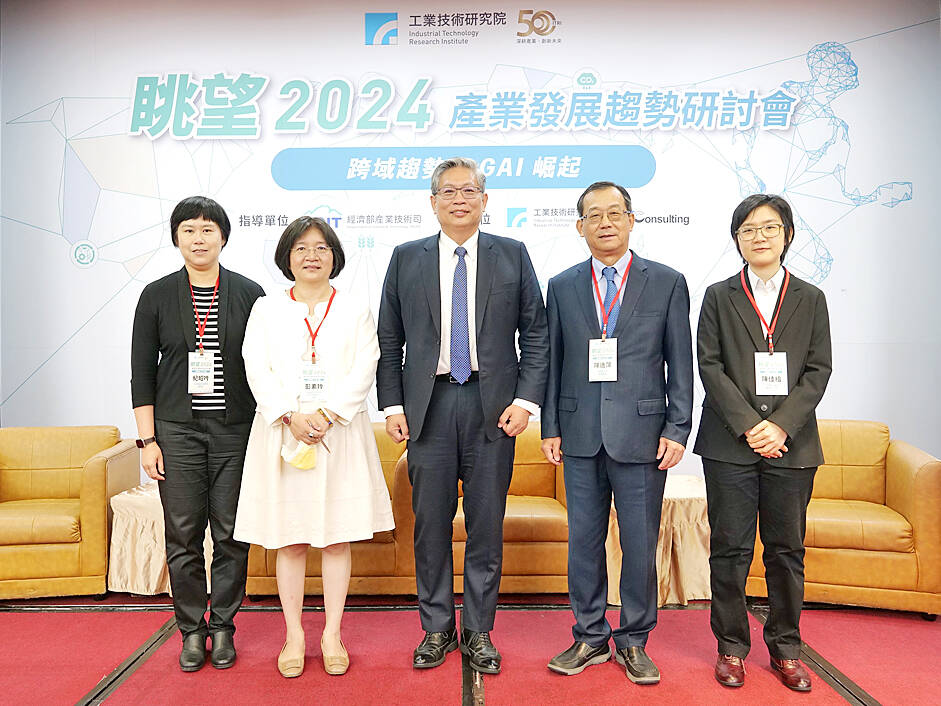The manufacturing sector’s production value is forecast to rise 5.49 percent year-on-year to NT$23.38 trillion (US$723.48 billion) next year, mainly driven by demand for emerging technology applications, the Industrial Technology Research Institute’s Industry, Science and Technology International Strategy Center (ISTI) said in a report yesterday.
The sector has shown signs of a recovery lately, the report said, citing factors such as consecutive months of increases in the manufacturing purchasing managers’ index of major economies and the gradual pickup of global trade volume, while inventory levels among Taiwanese manufacturers are returning to normal levels.
Despite the report, the center said it expects the sector’s production value to contract 10.68 percent to NT$22.17 trillion this year, as the output of four major industries drop by between 1.73 and 13.74 percent from last year after major central banks raised interest rates to curb inflation and dented market demand.

Photo courtesy of the Industrial Technology Research Institute
The four major pillars of the sector refer to the information and electronics industry, the chemical industry, the metals and machinery industry, and the livelihood industry — which includes textile and food production.
“With external demand improving, domestic investment turning positive and private consumption stabilizing, the outlook for Taiwan’s economic growth next year is positive, and the manufacturing sector would regain growth momentum,” ISTI analyst Chen Chia-ying (陳佳楹) said in the report.
However, geopolitical tensions, increasing economic polarization, China’s property market woes and commodity price fluctuations would pose risks to the global economy next year, which would in turn affect Taiwan’s export-oriented manufacturers, Chen said.
“There are also three major trend changes that warrant closer attention, including supply chain restructuring, accelerated technological innovations and advances in semiconductor technologies,” she said.
The report forecast a 7.57 percent annual increase in the production value of the information and electronics industry next year, as inventory adjustments are nearing an end and innovative applications such as 5G, automotive devices and low Earth orbit satellites continue to emerge.
It predicted a 4.07 percent growth in the output of the chemical industry next year, saying the steady demand for low-carbon, sustainable products would lead to a transformation in the industry.
Production value in the metals and machinery industry is forecast to increase 3.93 percent next year on the back of semiconductor companies’ global deployment, business opportunities related to green and smart manufacturing and demand from emerging markets, the report said.
The livelihood industry is expected to expand output 3.97 percent from this year, thanks to the easing pressure on food and raw material prices and less stressful inventory adjustments in the international market, it said, adding that textile makers are to see strong growth momentum next year due to the Summer Olympics Games in Paris.

Nvidia Corp’s demand for advanced packaging from Taiwan Semiconductor Manufacturing Co (TSMC, 台積電) remains strong though the kind of technology it needs is changing, Nvidia CEO Jensen Huang (黃仁勳) said yesterday, after he was asked whether the company was cutting orders. Nvidia’s most advanced artificial intelligence (AI) chip, Blackwell, consists of multiple chips glued together using a complex chip-on-wafer-on-substrate (CoWoS) advanced packaging technology offered by TSMC, Nvidia’s main contract chipmaker. “As we move into Blackwell, we will use largely CoWoS-L. Of course, we’re still manufacturing Hopper, and Hopper will use CowoS-S. We will also transition the CoWoS-S capacity to CoWos-L,” Huang said

Nvidia Corp CEO Jensen Huang (黃仁勳) is expected to miss the inauguration of US president-elect Donald Trump on Monday, bucking a trend among high-profile US technology leaders. Huang is visiting East Asia this week, as he typically does around the time of the Lunar New Year, a person familiar with the situation said. He has never previously attended a US presidential inauguration, said the person, who asked not to be identified, because the plans have not been announced. That makes Nvidia an exception among the most valuable technology companies, most of which are sending cofounders or CEOs to the event. That includes

TARIFF TRADE-OFF: Machinery exports to China dropped after Beijing ended its tariff reductions in June, while potential new tariffs fueled ‘front-loaded’ orders to the US The nation’s machinery exports to the US amounted to US$7.19 billion last year, surpassing the US$6.86 billion to China to become the largest export destination for the local machinery industry, the Taiwan Association of Machinery Industry (TAMI, 台灣機械公會) said in a report on Jan. 10. It came as some manufacturers brought forward or “front-loaded” US-bound shipments as required by customers ahead of potential tariffs imposed by the new US administration, the association said. During his campaign, US president-elect Donald Trump threatened tariffs of as high as 60 percent on Chinese goods and 10 percent to 20 percent on imports from other countries.

INDUSTRY LEADER: TSMC aims to continue outperforming the industry’s growth and makes 2025 another strong growth year, chairman and CEO C.C. Wei says Taiwan Semiconductor Manufacturing Co (TSMC, 台積電), a major chip supplier to Nvidia Corp and Apple Inc, yesterday said it aims to grow revenue by about 25 percent this year, driven by robust demand for artificial intelligence (AI) chips. That means TSMC would continue to outpace the foundry industry’s 10 percent annual growth this year based on the chipmaker’s estimate. The chipmaker expects revenue from AI-related chips to double this year, extending a three-fold increase last year. The growth would quicken over the next five years at a compound annual growth rate of 45 percent, fueled by strong demand for the high-performance computing